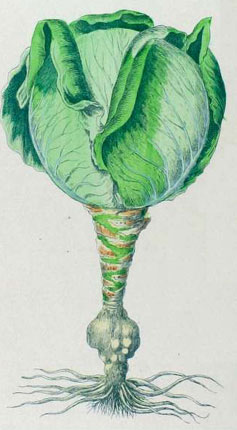White cabbage – Brassica oleracea
Biennial plant up to 40-60 cm with a very large fleshy leaves, families krestotsvetnыh (Cruciferae). Cabbage is cultivated in almost all climatic zones. Used for therapeutic purposes leaves of plants.

White cabbage – chemical composition
Cabbage leaves contain sugar, proteins, fats, fiber, vitamins (C, P, B1, B2, B6, K, D, carotene), enzymes, mineral salts, antibacterial agent - lysozyme. Besides, fresh cabbage leaves found thioglycosides (glikobrassidin, neoglikobrassidin), sulfur.
White cabbage – Pharmacological properties
Experimental studies have established, that feeding fresh cabbage rabbits and guinea pigs prevents the emergence of experimental animals histamine ulcers. In fresh cabbage discovered anti-ulcer factor, called vitamin U. Currently vitamin U prepared synthetically and is a chloride metilmetioninsulfoniya.
Pharmacological studies have shown that the drug, it has low toxicity, It has a healing and protective effect in experimental stomach ulcers in rats. The drug has antihistamine properties and antiserotoninovym. Vitamin U exerts beneficial preventive effect on the development of experimental atherosclerosis in rabbits, which is primarily manifested in the less significant build-up of serum cholesterol and the reduction of lipoidoza aorta in experimental rabbits. However, experimental studies and clinical monitoring of patients showed, that the use of pure metilmetioninsulfoniya chloride gives a smaller effect, than the use of natural cabbage juice, as the tissue of cabbage juice has antibacterial addition, bacteriostatic, fungistatic and fungicidal properties.
Besides, cabbage contains volatile, that, as it was shown in the experiment, have an antibacterial effect even on Staphylococcus aureus and Mycobacterium tuberculosis;
White cabbage – medical applications
For the first time about the healing of gastric ulcer and duodenal ulcer in patients with cabbage juice has been reported in 1952 city, that was the beginning of the use of cabbage juice in fresh and dried form for the treatment of peptic ulcer disease in clinics around the world. It has been suggested, Vitamin U has a favorable effect on the exchange of thiamine, and choline, and thereby improves the metabolism of the gastric mucosa, what, apparently, and increases its resistance to damaging factors, and in the presence of the ulcer accelerates tissue regeneration. The positive effect of vitamin U in the gastric peristalsis, motor-evacuation activity of the intestine, a beneficial effect on intestinal flora.
In the appointment of cabbage juice (by 1/2 cup 2-3 times a day in the form of heat to the food) patients with gastric ulcer and duodenal ulcer disappeared or decreased pain, I stopped vomiting, nausea, heartburn, constipation. On the acidity of gastric juice drug affects ambiguously. So, when it increased gipatsidnyh gastritis, at giperatsidnyh - or unchanged, or tended to decrease; under normal initial acidity of gastric contents significant changes were observed. A number of clinicians note a positive effect of cabbage juice in diseases of the liver (gepatitы, angiokholity). In patients with reduced pain in the liver, dyspeptic symptoms disappear, increased appetite.
Clinical studies have also shown, that vitamin U improves lipid exchange and has a beneficial effect on patients with coronary atherosclerosis. Vitamin U is effective for eczema, psoriaze, neurodermatitis, superficial allergic vasculitis.
Cabbage is also a valuable product in the medical and dietary. Its include patients diet, gout sufferers, cholelithiasis, because it contains virtually no purine bases. Cabbage is one of the main sources of not only water-soluble vitamins, and mineral salts. So, high content of potassium in plants can promote stimulation daureza and can recommend the cabbage, its juice and other food dishes from the plant diseases of the heart and kidneys. Cabbage is indicated in patients with atherosclerosis, since pectin compound, contained therein, contribute to the neutralization of toxic substances, removal of cholesterol, fiber and improves motor function of the intestine. Besides, in the cabbage contains tartaric acid, retarding the conversion of carbohydrates into fats. In this connection it is advisable; include cabbage diet, aimed at reducing body weight. In sauerkraut juice contains a lot of lactic acid, so it is recommended to use sick, suffering from diabetes.
White cabbage – Dosage Forms, Dosing and Administration
Metilmetioninsulfoniya chloride – vitamin in. The activated form of methionine. It stimulates healing of mucosal lesions of the gastrointestinal tract. It is used for stomach ulcers and duodenal ulcers, chronic gastritis with normal, reduced and increased gastric secretion, when gastralgiyah. Is inside after eating at 0.05-0.1 g for 30-40 days.
Side effects. If you are hypersensitive nausea, vomiting, increased pain, that disappear with dose reduction or drug discontinuation.
